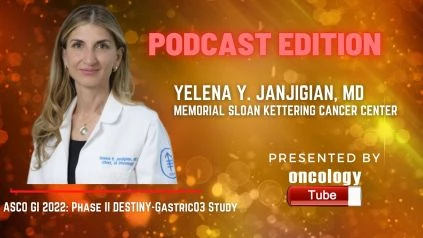Yelena Y. Janjigian, MD, Cheif, Gastrointestinal Oncology Service at Memorial Sloan Kettering Cancer Center. In this interview Dr. Janjigian speaks about the ASCO GI 2022 Abstract – Dose-escalation and dose-expansion study of trastuzumab deruxtecan (T-DXd) monotherapy and combinations in patients (pts) with advanced/metastatic HER2+ gastric cancer (GC)/gastroesophageal junction adenocarcinoma (GEJA): DESTINY-Gastric03.
Origins:
T-DXd is a humanized anti-HER2 monoclonal antibody with a tetrapeptide-based cleavable linker and a topoisomerase I inhibitor payload in an antibody-drug combination. T-DXd is approved in the United States and Israel for HER2+ advanced/metastatic GC/GEJA after a trastuzumab-based treatment, as well as GC after chemotherapy (Japan). In DESTINY-Gastric01, T-DXd outperformed standard chemotherapy in Japanese and Korean patients with advanced HER2+ GC/GEJA who had previously received two treatments. T-DXd combos have shown to have promising anticancer efficacy in preclinical studies. DESTINY-Gastric03 is the first study in GC/GEJA to look at T-DXd combos.
Methodologies:
DESTINY-Gastric03 (NCT04379596) is a multicenter, open-label, phase 1b/2, 3+3 dose-escalation (part 1) and -expansion (part 2) study in advanced/metastatic HER2+ GC/GEJA. Pts with locally confirmed HER2+ GC/GEJA (IHC 3+ or IHC 2+/ISH+) who progressed on/after 1 prior trastuzumab-containing treatment were given T-DXd intravenously (IV) every 3 weeks + allocated combination in phase 1. Safety and the recommended phase 2 dose were the primary goals (RP2D). A secondary goal was preliminary antitumor activity, and a secondary endpoint was the confirmed objective response rate (ORR). The T-DXd + fluoropyrimidine cohorts are presented.
Outcomes:
In part one, 15 patients were given T-DXd plus IV 5-fluorouracil (5-FU) and 10 patients were given T-DXd plus oral capecitabine (Cap). In addition to trastuzumab, all patients had previously had 5-FU and/or Cap, as well as a median of two (range, one to five) prior lines of therapy. Anemia (33), decreased neutrophil count (33), nausea (13), and stomatitis (13) were the most common grade 3 AEs (percentage) with T-DXd + 5-FU and decreased neutrophil count (40), anemia (30), and nausea (20) with T-DXd + Cap. T-DXd 5.4 mg/kg + 5-FU 800 mg/m2 and T-DXd 5.4 mg/kg + Cap 1000 mg/m2 were given twice daily as starting doses (BID). With T-DXd 6.4 mg/kg + 5-FU 800 mg/m2, there were two dose-limiting toxicities of grade 3 stomatitis; this dose exceeded the maximum tolerated dose and was terminated. T-DXd 6.4 mg/kg + 5-FU 600 mg/m2 BID and T-DXd 6.4 mg/kg + Cap 1000 mg/m2 BID were the RP2Ds. T-DXd + Cap had preliminary confirmed and confirmed + unconfirmed ORR at the RP2D of 3/7 and 5/7, respectively; 3/3 pts had confirmed ORR at the beginning dose of T-DXd + Cap. T-DXd + 5-FU ORR data is not yet complete.
Findings:
Preliminary phase 1 data from the first T-DXd + fluoropyrimidine combo research in HER2+ GC/GEJA demonstrate tolerance and feasibility of the RP2Ds for T-DXd + 5-FU and T-DXd + Cap. In extensively pretreated, trastuzumab- and fluoropyrimidine-refractory, HER2+ GC/GEJA, preliminary ORR with the T-DXd + Cap RP2D (n = 7) revealed effectiveness with this combination. This research is still underway, and further combinations and follow-up are in the works. NCT04379596 is the number for the clinical trial.

